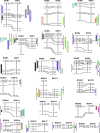QTL mapping reveals the genetic architecture of loci affecting pre- and post-zygotic isolating barriers in Louisiana Iris
- PMID: 22702308
- PMCID: PMC3490880
- DOI: 10.1186/1471-2229-12-91
QTL mapping reveals the genetic architecture of loci affecting pre- and post-zygotic isolating barriers in Louisiana Iris
Abstract
Background: Hybridization among Louisiana Irises has been well established and the genetic architecture of reproductive isolation is known to affect the potential for and the directionality of introgression between taxa. Here we use co-dominant markers to identify regions where QTL are located both within and between backcross maps to compare the genetic architecture of reproductive isolation and fitness traits across treatments and years.
Results: QTL mapping was used to elucidate the genetic architecture of reproductive isolation between Iris fulva and Iris brevicaulis. Homologous co-dominant EST-SSR markers scored in two backcross populations between I. fulva and I. brevicaulis were used to generate genetic linkage maps. These were used as the framework for mapping QTL associated with variation in 11 phenotypic traits likely responsible for reproductive isolation and fitness. QTL were dispersed throughout the genome, with the exception of one region of a single linkage group (LG) where QTL for flowering time, sterility, and fruit production clustered. In most cases, homologous QTL were not identified in both backcross populations, however, homologous QTL for flowering time, number of growth points per rhizome, number of nodes per inflorescence, and number of flowers per node were identified on several linkage groups.
Conclusions: Two different traits affecting reproductive isolation, flowering time and sterility, exhibit different genetic architectures, with numerous QTL across the Iris genome controlling flowering time and fewer, less distributed QTL affecting sterility. QTL for traits affecting fitness are largely distributed across the genome with occasional overlap, especially on LG 4, where several QTL increasing fitness and decreasing sterility cluster. Given the distribution and effect direction of QTL affecting reproductive isolation and fitness, we have predicted genomic regions where introgression may be more likely to occur (those regions associated with an increase in fitness and unlinked to loci controlling reproductive isolation) and those that are less likely to exhibit introgression (those regions linked to traits decreasing fitness and reproductive isolation).
Figures

Similar articles
-
The genetic architecture of reproductive isolation in Louisiana irises: flowering phenology.Genetics. 2007 Apr;175(4):1803-12. doi: 10.1534/genetics.106.068338. Epub 2007 Jan 21. Genetics. 2007. PMID: 17237511 Free PMC article.
-
Integrating Bayesian genomic cline analyses and association mapping of morphological and ecological traits to dissect reproductive isolation and introgression in a Louisiana Iris hybrid zone.Mol Ecol. 2018 Feb;27(4):959-978. doi: 10.1111/mec.14481. Epub 2018 Feb 17. Mol Ecol. 2018. PMID: 29319908
-
Transmission ratio distortion results in asymmetric introgression in Louisiana Iris.BMC Plant Biol. 2010 Mar 18;10:48. doi: 10.1186/1471-2229-10-48. BMC Plant Biol. 2010. PMID: 20298609 Free PMC article.
-
Hybrid fitness, adaptation and evolutionary diversification: lessons learned from Louisiana Irises.Heredity (Edinb). 2012 Mar;108(3):159-66. doi: 10.1038/hdy.2011.65. Epub 2011 Jul 27. Heredity (Edinb). 2012. PMID: 21792222 Free PMC article. Review.
-
Evolutionary processes from the perspective of flowering time diversity.New Phytol. 2020 Mar;225(5):1883-1898. doi: 10.1111/nph.16205. Epub 2019 Oct 26. New Phytol. 2020. PMID: 31536639 Review.
Cited by
-
Genomics and the origin of species.Nat Rev Genet. 2014 Mar;15(3):176-92. doi: 10.1038/nrg3644. Nat Rev Genet. 2014. PMID: 24535286 Review.
-
Genetic Map Construction and Detection of Genetic Loci Underlying Segregation Distortion in an Intraspecific Cross of Populus deltoides.PLoS One. 2015 May 5;10(5):e0126077. doi: 10.1371/journal.pone.0126077. eCollection 2015. PLoS One. 2015. PMID: 25942445 Free PMC article.
-
Interspecific tests of allelism reveal the evolutionary timing and pattern of accumulation of reproductive isolation mutations.PLoS Genet. 2014 Sep 11;10(9):e1004623. doi: 10.1371/journal.pgen.1004623. eCollection 2014 Sep. PLoS Genet. 2014. PMID: 25211473 Free PMC article.
References
-
- Mallet J. Hybridization as an invasion of the genome. Trends in Ecology & Evolution. 2005;20(5):229–237. - PubMed
-
- Whitney KD, Ahern JR, Campbell LG, Albert LP, King MS. Patterns of hybridization in plants. Perspectives in Plant Ecology, Evolution and Systematics. 2010;12:175–182.
-
- Coyne JA, Orr HA. Speciation. Sinauer Associates, Sunderland Massachusetts; 2004.
-
- Arnold ML, Wilkinson P, Shaw DD, Marchant AD, Contreras N. Highly repeated DNA and allozyme variation between sibling species - Evidence for introgression. Genome. 1987;29(2):272–279.
Publication types
MeSH terms
LinkOut - more resources
Full Text Sources
Research Materials

